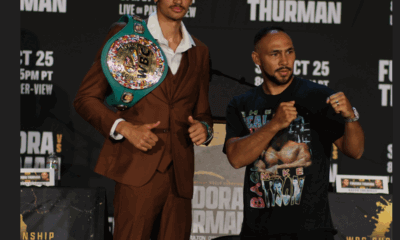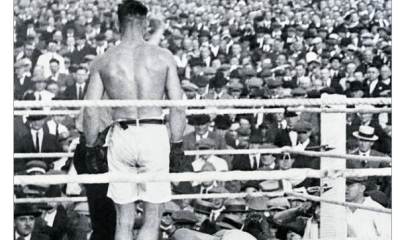Canada and USA
Fireman Jim Demolishes Jack Dempsey: The Story Behind the Story
Monday, Feb. 13, is the 100th anniversary of one of the most curious fights in the annals of boxing. On this date in 1917, at Murray, Utah, future heavyweight champion Jack Dempsey was knocked out in the opening round by Fireman Jim Flynn, a journeyman who had won only ten of his last 32 fights. There are varying accounts of the fight and the question of whether Dempsey went into the tank is a question that vexes boxing historians to this very day.
Dempsey went on to fame and fortune. In 1962, a panel of 40 experts assembled by The Ring magazine named him the greatest heavyweight champion ever. That placement struck many as an affront to Joe Louis. After winning the title, Dempsey made only five successful defenses. But whatever one’s opinion of Dempsey, it’s undeniable that he seized the imagination of the public like no athlete before him. With assists from promoter Tex Rickard and his wily manager Doc Kearns, he introduced the phrase “Million Dollar Gate” into the lexicon. He overshadowed his era, wrote Paul Gallico, and this was no ordinary era but America’s Golden Era of Sports.
How did Dempsey lose to a palooka like Fireman Jim Flynn, and lose in such a humiliating fashion?
FIREMAN JIM
Fireman Jim Flynn was born Andrew Chiariglione in Hoboken, New Jersey in 1879. Like many fighters of Italian ancestry, he found it advantageous to adopt an Irish ring name. At times he also used the aliases Andrew Haynes and Andrew Haymes.
Flynn heeded Horace Greeley’s admonition: “Go West, Young Man.” At age nineteen, he surfaces in Butte, Montana, where he had his first 11 recorded fights. A wild-and-woolly copper mining town, Butte was an ideal nursery for a boxer. Prizefighting, one might say, was the municipal sport. Stanley Ketchel, the legendary Michigan Assassin, had his first 39 fights in Montana, 26 in Butte.
In 1902, Flynn moved 900 miles south across the Rocky Mountains to Pueblo, Colorado, the city with which he would be identified. It was in Pueblo, a steel making city that was also an important railroad hub, that Flynn acquired his nickname. But he wasn’t a conventional fireman. He heaved coal into furnaces on steam locomotives.
Flynn had 47 fights under his belt when he made his first foray into California, opposing Tommy Burns in Los Angeles. Burns had won the vacant heavyweight title six months earlier, upending Marvin Hart, and was making his first title defense. The Pueblo fireman weighed 169 pounds for this contest. Tommy Burns came in at 170.
Flynn didn’t fare well. Burns knocked him senseless before the referee stopped the contest in the 15th round. Fireman Jim later had two fights with Jack Johnson, the second of which was contested for Johnson’s heavyweight title. In those fights he also absorbed bad beatings. But Flynn had some good moments during his choppy career. In 1910 he won a newspaper decision over Sam Langford. This was the middle match of his three encounters with the fabled Boston Tar Baby. He was knocked out in the other two.
When Fireman Jim met Dempsey he was 37 years old and a full blown heavyweight, carrying 190 pounds, or thereabouts, on his 5’10 ½”-inch frame. And for all the tribulations that he had experienced inside the ring, one could certainly build a case for him against the man that Damon Runyon would dub the Manassa Mauler. Dempsey was a fearsome hitter, but at age twenty-one he was still a work in progress. The presumption was that Flynn’s greater experience would serve him well if he could carry the fight into the late rounds.
——
Nowadays Murray, Utah is a white collar suburb of Salt Lake City. The leading employers are health care providers. But in 1917, Murray was an industrial city that housed one of America’s largest smelters. A trolley line ran down the center of the main street. The air was thick with soot.
Prizefighting was illegal in Utah, but that was a joke. Promoters circumvented the law by billing their shows as exhibitions. Moreover, the authorities were disinclined to intercede if a portion of the proceeds was earmarked for a worthwhile cause. That was the case with Dempsey-Flynn. The promoter cast his show as a benefit for the volunteer fire department. The fight was held in their building. (It would subsequently be written that the fire department received only $250 of an estimated $3000 gate.)
THE FIGHT
Prior to World War I, very few boxing writers were accorded the dignity of a byline. The inconsistencies in so many post-fight reports are undoubtedly related to this convention. Without the transparency of a byline, ring correspondents, often stringers, were more disposed to play loose with the facts.
Some newspaper accounts say that Flynn knocked Dempsey cold with the first punch that he threw, a punch that landed within 10 seconds of the opening bell. At the other end of the spectrum we have the recollection of Billy Roche, a famous referee, who would write that Flynn knocked Dempsey down six times before Dempsey was all in. When he wrote this, Roche must have had Alzheimer’s. He actually worked Fireman Jim’s corner.
Several Dempsey biographers, including Roger Kahn, will only allow that Dempsey was vanquished inside of the first two minutes. It wasn’t the referee who stopped the fight according to most re-tellings, but rather Dempsey’s brother Bernie who was working as his chief second. “I was just getting my second wind when Bernie threw in the towel,” recalled Dempsey in his 1977 autobiography written with his stepdaughter Barbara Piattelli Dempsey. This version of events crept into Dempsey’s obituary in the New York Times which said that he was knocked down several times before his brother interceded to stop the carnage.
As mentioned, during this era first-hand reports weren’t always dependable, but newspaper stories by eyewitnesses, as a rule of thumb, are yet invariably more trustworthy than “facts” set down long after the fact. Turning to the next day’s story in the Salt Lake City Deseret Evening News, here is what we discover:
Fireman Jim hit Dempsey with four punches, two on each side of the head, before knocking him into dreamland with a terrific left hook to the jaw. Dempsey got in a few licks too; the fighting was described as fierce. The final punch arrived at the 25-second mark (likely an estimate). There is no mention of Dempsey’s brother throwing in the towel and, by all indications, the referee saw no reason to count; that would have been superfluous.
WAS IT A FIX?
Almost immediately, there were rumors that the fight was fixed. Dempsey’s soon-to-be ex-wife, an older woman named Maxine Cates, threw fuel on the fire in interviews conducted after their marriage had dissolved. But Maxine, a footloose woman of easy virtue – when Dempsey met her in 1916 she was working in a Salt Lake City bordello – wasn’t the most credible witness because she had an axe to grind. Her brief union with Dempsey left her bruised, emotionally and physically.
Boxing historian Monte Cox authored the most in-depth analysis of the fixed-fight hypothesis. For Cox, the most damning evidence that the fight was fixed appeared in the tenth chapter of a 23-part series about Dempsey that ran in 1920 in the Chicago Tribune. The headline “Dempsey’s Lone KO of Career a Raw Frame Up” and sub-headline “Needed Money so Flopped to Flynn” said it all.
The author of the series, identified only as “Eye Witness,” claimed to have interviewed three Salt Lake City boxing insiders – a gym operator, a newspaperman, and Dempsey’s manager of the moment – who were all at the fight and had knowledge that it was bogus. “Dempsey, an unknown struggling, hungry fighter at the time, had the necessary motives to accept a payment to lay down,” concluded Cox who noted that Dempsey never fought in Utah again.
There is, however, a fly in the ointment. It’s very easy for a boxer to play act and fool the spectators into thinking that he is rendering an honest effort. In a sense, boxers rehearse when they spar. However, it takes a very good actor to feign grogginess for any considerable period of time while people are crowding in on him. According to the ringside scribe for the Deseret Evening News, “Dempsey was insensible for several minutes and when brought back from the land of nod he evidently thought he was still in the prize ring and attempted to slug his seconds.”
Reminiscing, Dempsey said that when he walked into the ring he realized that he hadn’t warmed up properly. This reporter is inclined to give him the benefit of the doubt. With all due respect to Monte Cox, I sense that the fight was legit.
Dempsey caught up with Fireman Jim again the next year in Fort Sheridan, Illinois, an Army post on the shore of Lake Michigan, and knocked him out in the opening round. But Flynn soldiered on. Following his retirement at age 44, he reportedly drove a cab for a time in Phoenix. He died at age 55 of heart disease at a hospital in Los Angeles.
Jack Dempsey lived to a ripe old age, dying of natural causes in 1983 at age 87 in the bedroom of his apartment in New York. Long after his fighting days were over, he remained in the public eye. “When he entered a crowded room,” wrote Paul Gallico of Dempsey the elder statesman, “he was never less than 12 feet tall.” Fireman Jim Flynn couldn’t extinguish the flame.
Check out more boxing news on video at The Boxing Channel.
-

 Book Review4 weeks ago
Book Review4 weeks agoMark Kriegel’s New Book About Mike Tyson is a Must-Read
-

 Featured Articles3 weeks ago
Featured Articles3 weeks agoThe Hauser Report: Debunking Two Myths and Other Notes
-

 Featured Articles3 weeks ago
Featured Articles3 weeks agoMoses Itauma Continues his Rapid Rise; Steamrolls Dillian Whyte in Riyadh
-

 Featured Articles3 weeks ago
Featured Articles3 weeks agoNikita Tszyu and Australia’s Short-Lived Boxing Renaissance
-

 Featured Articles4 weeks ago
Featured Articles4 weeks agoKotari and Urakawa – Two Fatalities on the Same Card in Japan: Boxing’s Darkest Day
-

 Featured Articles3 weeks ago
Featured Articles3 weeks agoIs Moses Itauma the Next Mike Tyson?
-

 Featured Articles2 weeks ago
Featured Articles2 weeks agoBoxing Odds and Ends: Paul vs ‘Tank,’ Big Trouble for Marselles Brown and More
-

 Featured Articles3 weeks ago
Featured Articles3 weeks agoAvila Perspective, Chap. 340: MVP in Orlando This Weekend




















